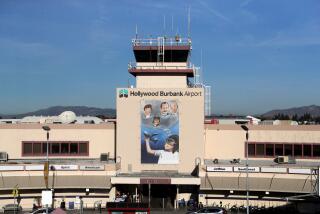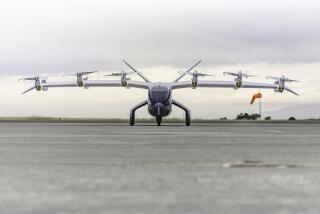FAA Proposes to Tighten Rein on Valley Air Traffic
Under rule changes proposed by the Federal Aviation Administration, private pilots who now fly free as birds over much of the San Fernando and San Gabriel valleys would be required to check in with air-traffic controllers at Burbank Airport.
The FAA on Wednesday invited pilots and others to a public meeting Sept. 25 at the Air National Guard base at Van Nuys Airport to discuss the proposed designation of an Airport Radar Service Area--called an ARSA--around Burbank Airport, beginning Jan. 16.
The ARSA would cover a 10-mile radius around the airport, reaching Pasadena on the east, Reseda on the west, Sunland on the north and Beverly Hills on the south. The zone would include both Van Nuys Airport and Whiteman Airport in Pacoima.
Burbank, unlike the other two fields, handles flights by commercial jetliners, which are under radar observation or guidance from takeoff to landing.
The proposed zone is designed to alleviate complaints of some air-traffic controllers and commercial pilots that private planes operating outside the radar guidance system sometimes fly into the takeoff and landing paths of jetliners. Except when taking off and landing, jetliners usually fly at much higher altitudes than the smaller planes.
Burbank is one of 22 airports in the United States that the FAA plans to surround with such zones for safety reasons, said Stan Stuka, assistant manager for programs at the Burbank Terminal Radar Approach Control Facility.
The FAA’s responsibility is to keep airliners “separate from known traffic,” he said, but “known traffic” includes only those planes with which the tower is in radio contact. Frequently, there is “unknown traffic” on the screens of Burbank radar controllers, he said, blips caused by private planes from the other airfields.
Air traffic now can take off from Van Nuys or Whiteman under local tower control, then continue without contacting the Burbank tower.
Altitude Often Unknown
Although the private planes appear on Burbank radar screens, their altitude is often unknown. Some private planes are equipped with transponders, which signal the plane’s altitude to a radar screen, but some are not.
Thus controllers sometimes are unable to tell whether two converging blips reflect planes on a collision course, or planes that are safely separated by thousands of feet in altitude, Stuka said. Because the controllers are always in radio contact with airline pilots, they inform them of “unknown” traffic in their area and it is up to the pilots not to collide.
The aim of the proposed change is to eliminate “the environment of known and unknown aircraft,” he said. “We are going to know the traffic in those areas.”
But the Van Nuys Airport traffic control chief questions whether the Burbank staff will be able to handle the increased work load.
Under the proposed rules, pilots, with some exceptions, would have to contact the Burbank tower by radio and ask for permission to enter the zone. If the tower did not respond, or denied permission, pilots would have to fly around or over the zone, which would extend to 4,000 feet above the ground
Zone Mushroom-Shaped
The safety zone would be mushroom-shaped. It would begin at ground level within five miles of Burbank Airport. But, between 5 and 10 miles from the airport, it would begin at 1,200 feet, allowing pilots approaching or leaving Whiteman and Van Nuys airports to fly beneath it for a short period.
Planes landing at Van Nuys and in contact with the tower there would not have to contact the Burbank tower as well, said Dean Cooper, chief of the Burbank tower.
There is also a 1.5-mile “keyhole” in the northern edge of the zone, a corridor over the Foothill Freeway, for planes landing or taking off from Whiteman. But planes taking off toward the south “will have to turn to the north almost immediately if they’re not talking to Burbank, or they’re going to run into the ARSA,” Cooper said.
Although two-way radios are not required equipment on all private aircraft, they are required by the FAA for some planes, including all aircraft using Van Nuys Airport. In practice, aviation sources said, virtually all private planes now have radios.
Some Planes Lack Radios
A few planes based at Whiteman have no radios, Cooper said, which would require their pilots to figure out routes over or around the ARSA.
Cooper said he “gets heartburn” trying to determine how the aircraft controllers at Burbank will handle the additional load from Van Nuys, the third busiest airfield in the world in takeoffs and landings, with more than 500,000 a year. About 1,100 aircraft are based there.
He estimated that Van Nuys traffic seeking permission to enter the ARSA would contact the Burbank tower 540 times on an average day. “I don’t know how they’ll service them,” he said. “Those people are just going to keep popping up on their radios.”
The FAA, which won a showdown with the air-traffic controllers in a 1981 strike, has no plans to hire more controllers at Burbank to handle the load, he said.
Stuka said the controllers now talk to an average 800 flights a day, including those just passing over the field. Richard Morrison, assistant air traffic manager for the FAA at Burbank, said the airport could hire more controllers because not all the currently authorized 32 slots are filled. He would not say how many vacancies there are.
More to Read
Sign up for Essential California
The most important California stories and recommendations in your inbox every morning.
You may occasionally receive promotional content from the Los Angeles Times.










